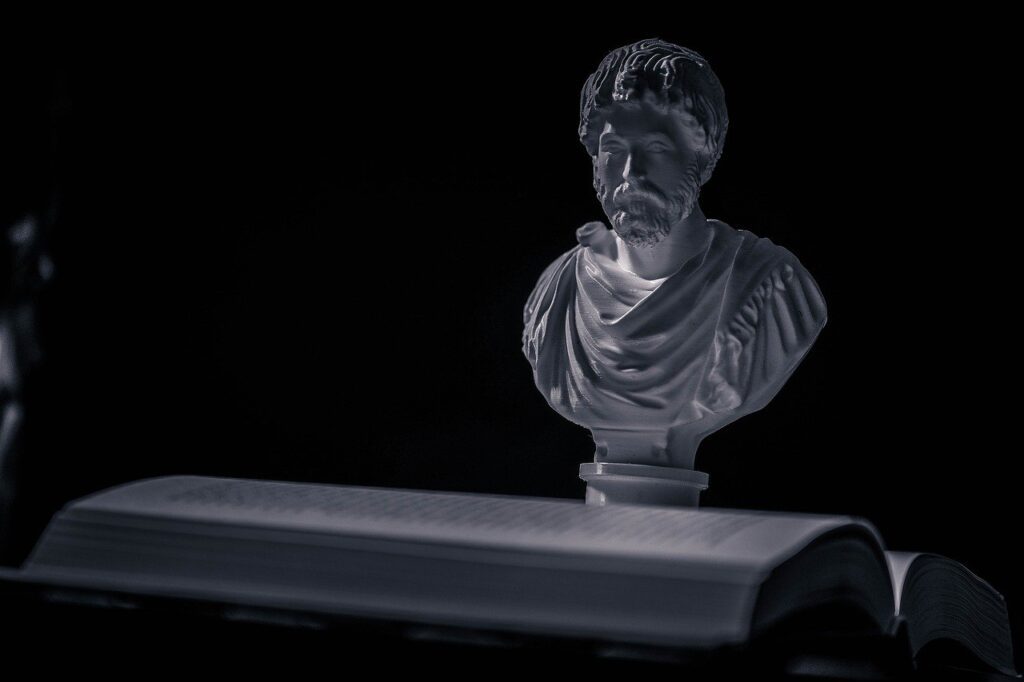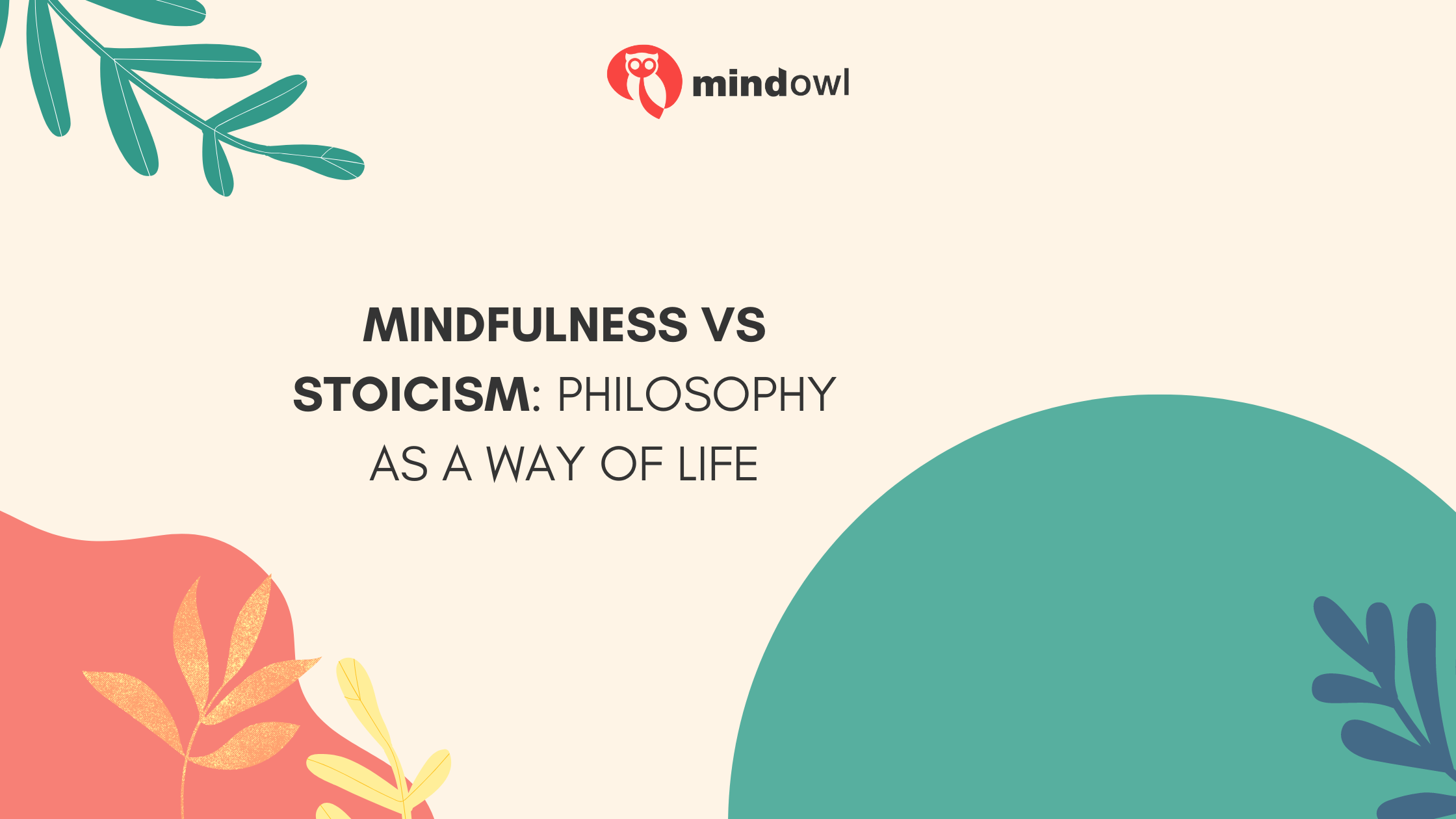Life can get pretty overwhelming, right? With all the noise and fast pace of today’s world, finding peace and clarity often feels like searching for a needle in a haystack. Ever wondered if there’s a way to navigate life’s challenges more smoothly? In walks Stoicism and mindfulness, two ancient philosophies that promise just that—ways to deal with life’s ups and downs.
Here’s something interesting: While Stoicism hails from Greco-Roman thinking, focusing on logic and personal ethics, mindfulness roots in Buddhist traditions aiming at awareness and living in the moment.
Despite their different origins, both paths aim to help us lead happier lives by mastering our thoughts. This article will shed light on how blending these age-old wisdoms could be your ticket to handling daily stress better.
Ready for some peace of mind? Keep reading!
Key Takeaways
- Stoicism and mindfulness come from ancient Greece and Buddhist traditions, focusing on inner peace and clarity.
- They share goals like living better lives by handling stress calmly but use different methods; Stoicism uses logic and ethics while mindfulness focuses on awareness without judgment.
- Practices from both philosophies, such as meditation in mindfulness and prosochê in Stoicism, help us focus on what we can control.
- While they have their differences, combining the two can lead to greater resilience, personal growth, and a balanced life.

Understanding Stoicism and Mindfulness: A Brief Overview
Diving into Stoicism and mindfulness reveals an intriguing world of mental practices aimed at improving our lives. Stoicism, a school of thought from ancient Greece, teaches us to embrace things we cannot change.
It guides us towards focusing on our inner virtues and developing resilience against life’s ups and downs. Think Marcus Aurelius or Seneca; these folks didn’t just ponder over abstract ideas but lived by principles that aimed for inner peace amidst external chaos.
Mindfulness, while often associated with Buddhist traditions, is the practice of being fully present in the moment without judgment. Just like you tune into your favourite song, mindfulness asks you to tune into your current state — thoughts, bodily sensations, and environment — with kindness and curiosity.
This practice is not about escaping reality but engaging with it more deeply. Through exercises like focused breathing or meditation techniques such as loving-kindness (metta), individuals learn to calm their minds and understand their emotions better.
Despite originating from different cultures thousands of years apart, both these philosophies converge on similar ideals: fostering a life filled with clarity, compassion, and emotional intelligence.
The Intersection of Stoicism and Mindfulness
Stoicism and mindfulness share a common goal: to help us live better lives. Both philosophies teach us to focus on the present moment and handle life’s ups and downs with calm. Stoic practices encourage us to step back from our thoughts and feelings, looking at them without judgment.
This is much like mindfulness meditation, where the aim is also to observe thoughts without getting caught up in them.
The intersection of these traditions lies in their mutual pursuit of peace through inner control.
Mindful meditation, practiced by Buddhists, aligns closely with Stoic exercises that prepare us for life’s challenges. The key idea shared by both is focusing on what we can control and letting go of what we cannot.
Through this approach, they both help enhance our presence in the now, contributing to overall well-being.
Unpacking Stoic Mindfulness: Prosochê
Prosochê translates to “attention” in the world of Stoicism. It’s about staying sharp and knowing how our choices shape what we feel. This kind of mindfulness tells us to keep an eye on ourselves, making sure we don’t let unnecessary thoughts or feelings take over.
Think of it like having a mental checklist that helps keep your thoughts in line with what really matters.
This practice isn’t just old wisdom; it fits perfectly into our lives today. By focusing on prosochê, people can find a peaceful state of mind, free from judgment and more in tune with their surroundings.
It’s about living here and now but also preparing for whatever life throws at you next, all while keeping your peace intact.
The Role of Mindfulness in Buddhism
Mindfulness holds a central spot in Buddhism. It’s all about paying attention in the present moment without judgement. Buddhists see it as a key path to wisdom and self-transcendence.
Through practices like meditation, they aim to understand the mind and reduce suffering. This approach helps people accept what they cannot change.
Buddhist teachings emphasise inner peace and equanimity. Mindfulness lets individuals observe their thoughts and feelings from a distance, not getting caught up in them. This practice is rooted deeply in traditions such as Theravada Buddhism, where the goal is to achieve enlightenment by seeing things clearly for what they are – temporary and changing.
Contrasting Stoicism and Mindfulness: Key Differences
Let’s dive into the contrasting worlds of Stoicism and Mindfulness to uncover their key differences. Both philosophies offer a way to navigate life’s challenges, but they do so from distinct vantage points.
| Stoicism | Mindfulness |
|---|---|
| Focuses on using wisdom to control what’s within our power. | Emphasises awareness and acceptance of the present moment. |
| Centres on the virtue of rationality to face life’s challenges. | Encourages an open, non-judgmental attitude towards experiences. |
| Values emotional resilience by understanding and detaching from emotions. | Promotes experiencing feelings fully, but with a clear, calm mind. |
| Prosochê, the practice, is about applying ethical concepts to daily life. | Practices include meditation and breathing exercises to cultivate mindfulness. |
| Views challenges as opportunities to grow and strengthen character. | Sees every moment as an opportunity to practice mindfulness and compassion. |
| Often described as a philosophy of life with a focus on internal control. | Frequently found as a practice within larger spiritual traditions like Buddhism. |
From this comparison, we see that Stoicism and Mindfulness share common ground in seeking inner peace and equanimity. However, their methods and emphases on how to achieve these states differ significantly. Stoicism leans towards the intellectual and rational side of dealing with life’s unpredictabilities, while Mindfulness suggests a more experiential path, focusing on being present and fully engaged with our immediate experiences. Both paths offer valuable insights and tools for personal growth, highlighting that there’s not just one correct way to seek a fulfilling life.
The Potential Benefits of Combining Stoicism and Mindfulness
Mixing Stoicism and mindfulness brings many good points to our lives. It helps us deal with stress better by teaching us how to stay calm in tough situations. These philosophies show us that some things are out of our control, which is fine.
This way, we focus on what we can change and accept what we cannot.
Practising both also leads to personal growth. We become more resilient, learning from every up and down life throws at us. With tools like cognitive-behavioural therapy inspired by Stoic principles, we discover new ways to grow stronger mentally and emotionally.
This combination guides us towards a balanced life where challenges don’t shake our core but instead build our character.
Conclusion
We’ve looked at how mindfulness and Stoicism compare. They both teach us to control our thoughts and face life’s challenges with strength. Yet, they take different paths. Mindfulness tells us to live in the moment; Stoicism says to stay calm no matter what happens.
Putting them together could help us grow stronger and more resilient. It’s like taking the best parts of two worlds for a better way of living.
FAQs
1. What’s the main difference between mindfulness and stoicism?
Mindfulness, rooted in Buddhist teachings, focuses on living in the moment without judgement. Stoicism, a form of Greek philosophy preached by folks like Marcus Aurelius and Epictetus, teaches us to accept life’s ups and downs with a calm mind.
2. Can practising stoic mindfulness improve my life?
Absolutely! By combining stoic wisdom—like the dichotomy of control—with mindfulness practices, you learn to face anger and fear more calmly. It’s about focusing on what we can control and letting go of what we can’t.
3. How are Buddhism and Stoicism similar?
Both philosophies encourage us to see life as it is—Buddhism through meditation practices and Stoicism through exercises like negative visualisation. They help us deal with life’s challenges by teaching acceptance without judgement.
4. Is there any modern take on these ancient philosophies?
Yes, indeed! Modern mindfulness has been popularised by figures like Jon Kabat-Zinn, while modern Stoicism is making waves as a way of self-improvement 101 for many who find its teachings relevant today.
5. Do I need to follow religious practices to benefit from either philosophy?
Not at all! Both Buddhism’s approach to mindfulness and Stoic philosophy offer secular ways to enhance your daily life—they’re more about mental habits than religious beliefs.
6. How do I start incorporating these philosophies into my everyday routine?
Start small; maybe begin your day with a few minutes of mindful breathing or read a quote from a Stoic philosopher each morning. Remember, it’s not about perfection but practice—gradually integrating their teachings into how you handle daily tasks and challenges.
MindOwl Founder – My own struggles in life have led me to this path of understanding the human condition. I graduated with a bachelor’s degree in philosophy before completing a master’s degree in psychology at Regent’s University London. I then completed a postgraduate diploma in philosophical counselling before being trained in ACT (Acceptance and commitment therapy).
I’ve spent the last eight years studying the encounter of meditative practices with modern psychology.

